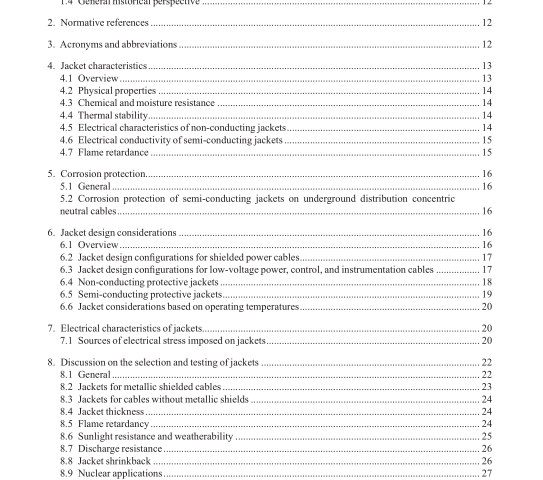IEEE 532-2021 pdf download.IEEE Guide for Selectng and Testng Jackets for Power, Instrumentaton, and Control Cables
4.2 Physical properties
Certain types of jackets can be modified to enhance particular physical or performance characteristics.
Depending on the application, the properties of importance may include one or more of the following:
— Toughness, tear, and abrasion resistance
— Suffcient fexibility and low coeffcient of friction to facilitate cable installation
— Flexibility at low temperatures
— Resistance to sunlight and weather
— Reliability for extra-heavy-duty service, such as required of portable power cables
— Flame retardancy
— Electrical characteristics when used in metallic shield bonding schemes
4.3 Chemical and moisture resistance
Jackets retard the ingress of water and environmental chemicals into the underlying core. Depending on the
application, the properties of importance may include one or more of the following:
— Resistance to high concentrations of organic and inorganic chemicals
— Resistance to ozone concentrations higher than normally encountered in the atmosphere
— Low moisture absorption
— Oil resistance
— Jackets over metallic shields, sheaths, and concentric neutral wires provide protection against corrosion
and oxidation
4.4 Thermal stability
The jackets are chosen for their thermal resistance and aging characteristics. Depending on the application, the properties of importance may include one or more of the following:
— Physical stability over a range of temperatures from the minimum installation temperature to the maximum rated conductor temperatures (normal operating, emergency overload, and short-circuit).
The actual jacket temperature with the conductor at these temperatures depends on the cable design and the installed environmental conditions.
— Resistance to shrinkback at a cable splice or termination.
— Resistance to heat aging during the jacket’s expected thermal environment based on the maximum rated conductor temperatures.
— Resistance to deformation during the jacket’s expected thermal environment based on the maximum rated conductor temperatures.
4.5 Electrical characteristics of non-conducting jackets
For shielded insulated conductors, non-conducting jackets should pass the appropriate electrical tests in dustry standards to isolate the metallic shield effectively from the environment. This isolation is required on bonding schemes, which include single-point grounded systems and cross-bonding schemes to reduce shieldcirculating current losses. Non-conducting jackets provide a level of isolation between the metallic shield or sheath and the system ground during system transients, including switching or lightning surges, as well as short-circuit operation.
For unshielded insulated conductors, non-conducting jackets provide resistance to electrical discharge likely to be experienced on power cables and reduce excessive surface leakage at conductor terminations of unshielded power and control cables.
4.6 Electrical conductivity of semi-conducting jackets
Semi-conducting jackets are used where it is considered desirable to have a relatively low resistance between
the concentric neutral wires or metallic shield and the earth. The purpose is to reduce the jacket potential
to earth ground during faults and to reduce jacket puncture during high lightning activity. Semi-conducting
jackets are rarely used on control and instrumentation cable. The general properties of importance include the
following:
— Electrical conductivity when required to function as an insulation shield or as a jacket on a shielded cable buried in the earth and when required to be grounded along its entire length
— Resistance to abnormal concentrations of organic chemicals, which could increase the resistivity of conductive shields and jackets
— Good dispersion of carbon black within the jacket material to provide uniform semiconductive properties from the metallic shield to ground
4.7 Flame retardance
Jacket materials are capable of resisting, retarding, or minimizing the propagation of flame. Flame retardancy
is accomplished with additives or is inherent in the chemical composition of the base polymer. The flameretardant characteristics are different for halogenated versus non-halogenated jacket materials. The risks and
applications should be considered based on those characteristics when selecting the jacket materials.
Different applications (such as cable tray, riser, and plenum) require different levels of fame retardancy. Riser
and plenum applications often have additional requirements such as low heat generation, low smoke, and low
toxicity.
Flame-retardant materials are not the same as fre-resistant or fre-rated materials that are used in cables designed to withstand a high-temperature fre while continuing to operate.
Depending on the application, the properties of importance may include one or more of the following:
— Application temperature
— Toughness
— Combustion byproducts
Additional information on fame retardant jackets can be found in 8.5.IEEE 532 pdf download.IEEE 532-2021 pdf download
IEEE 532-2021 pdf download

Leave a Reply